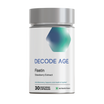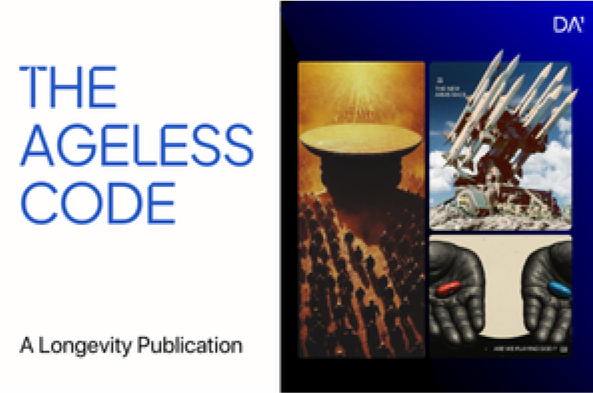Can we truly rethink the way we age? With the rise of powerful tools like biomarkers, machine learning (ML), and advances in longevity research, including cryopreservation [1], which aims to preserve biological structures for infinite longevity, to gene therapies and the ambitious visions of transhumanism — we may be entering an era where ageing is no longer seen as a passive decline, but as a process we can study, measure, and perhaps meaningfully intervene in.
As people around the world are living longer than ever before, attention is turning from just extending lifespan to enhancing the quality of those additional years. Ageing is a gradual, multifactorial process shaped by time, environment, and biology that leads to a loss of function, cellular damage, and increased vulnerability to age-related diseases. Understanding and intervening in this complex process has become one of the central challenges of modern science.
To navigate this complexity, researchers are increasingly turning to Artificial Intelligence (AI) [2]. With swift innovations, AI is revealing new opportunities for ageing to be better comprehended, and timely interventions to be offered, driving a wave of investment in the longevity sector.
The New Gold Rush
An instance of this level of momentum was OpenAI CEO Sam Altman's $180 million investment in Retro, a biotech firm that intends to increase the average human lifespan by a decade or more. To achieve this, Retro will study Yamanaka factors that transform an adult cell into induced pluripotent stem cells for longevity research [3]. Pluripotent stem cells are those cells who has the ability to transform themselves into any cells in the body. This shows just how seriously tech leaders are betting on the potential of longevity research.
AI is increasingly transforming the pace of decision-making in medical science and healthcare by means of advanced ML algorithms and deep learning (DL) techniques like Convolutional Neural Networks (CNNs) and data mining [4]. These technologies are brilliant at picking up hidden patterns from huge datasets, helping doctors diagnose, predict, and classify diseases more accurately than ever before. A study in South Korea compared how well AI and radiologists could detect breast cancer. AI came out ahead, identifying breast cancer masses with 90% accuracy compared to 78% for radiologists.
For instance, AI has demonstrated superior performance in early-stage breast cancer detection, outperformed dermatologists in diagnosing melanoma, a most dangerous type of skin cancer and suggesting treatments.
Is AI limited to just disease diagnosis?
AI’s impact goes beyond just diagnosing disease. It’s also beginning to reshape how we discover new medicines- another area long burdened by layers of complexity [4][5].
Traditional drug discovery is often slow, expensive, and inefficient, typically taking years, often decades to identify viable compounds. This process involves screening millions of molecules to find potential drug prospects, a task that is not only time-consuming and resource-intensive but also limited by inefficiency and inaccuracy. By using advanced ML and DL models, researchers can now make highly accurate predictions without burning through tons of time. This is especially crucial as longer human lifespans are often linked to a higher risk of chronic illnesses and age-related diseases such as cardiovascular conditions, cancer, and neurodegenerative disorders like Parkinson’s and Alzheimer’s. In drug discovery, ML algorithms are being trained to find new compounds that exclusively target the biology of ageing. Looking ahead, AI could play an even bigger role by offering real-time support and insights to clinicians, helping them make better, quicker decisions at the point of care.
A standout example is Insilico Medicine, which integrated its AI platforms, PandaOmics for drug target discovery and Chemistry42 for molecule designing, to create a treatment for a lung disease called idiopathic pulmonary fibrosis (IPF). Remarkably, the process took less than 18 months and cost a fraction of traditional approaches, illustrating how AI can dramatically compress timelines and lower costs in pharmaceutical Research & Development (R&D) [6].
Meanwhile, Atomwise is addressing these challenges through its AtomNet model, the first CNN built specifically for drug discovery. Unlike traditional approaches, AtomNet can analyze over 16 billion chemical compounds in less than 48 hours with much greater precision.
In partnership with the Drugs for Neglected Diseases initiative (DNDi), Atomwise has identified new classes of therapeutics for Chagas disease, a neglected tropical illness caused by the parasite Trypanosoma cruzi, which can lead to lifelong and sometimes life-threatening infection [7][8]. With the help of AtomNet, researchers discovered compounds that target a crucial protein called PEX14. By blocking this protein, they disrupt the parasite’s survival process, ultimately leading to its death.
DL has been a game-changer for AI, especially in the field of longevity science. It made it possible to train deep neural networks (DNNs) using huge and complex health datasets collected over time — something that used to be extremely hard to analyze effectively. These tools have dramatically expanded our understanding of the ageing process. One of the most exciting developments in this space is the rise of deep ageing clocks, algorithms that estimate biological age more accurately than ever before [9]. Unlike chronological age, biological age is often a better predictor of disease risk, personalized interventions and treatment outcomes [10].
Can AI predict diseases at cellular level?
Yes, AI is not only transforming how we treat disease but also how we detect and understand it at the most fundamental levels.
Consider mitochondrial dysfunction—a well-documented hallmark of ageing and cause of most chronic diseases. A recent study published in Nature showed how ML is helping uncover new layers of this connection, especially in the case of bladder cancer. Researchers used ML tools to sift through hundreds of mitochondria-related genes and were able to identify just a few that stood out for their strong links to tumor growth and immune activity [11]. Using advanced algorithms, scientists narrowed down 752 genes to a small set of highly predictive markers that reflect deeper problems in mitochondrial function, something that fuels cancer’s ability to grow and resist treatment. By integrating these ML-selected genes into a diagnostic model, researchers were able to develop a tool with strong potential for early detection and more targeted treatment strategies. This approach not only highlights the role of mitochondrial pathways in bladder cancer but also the ability of AI in precision oncology.
What’s exciting is that this kind of research is reshaping more than just how we approach cancer. It’s giving us a new lens on ageing and chronic illness as a whole. Mitochondrial dysfunction, for instance, isn’t limited to cancer; it shows up across a wide range of age-related diseases. And that’s exactly where longevity medicine comes in.
Unlike traditional medicine, which often focuses on treating illness after it appears, longevity medicine emphasizes prevention through rigorous testing, lifestyle interventions, and personalized healthcare strategies.
Conclusion
India, where the burden of chronic lifestyle diseases is rising and the demand for preventive care is growing [12], has much to learn from this approach. Currently, the longevity and wellness space in India is fragmented, often lacking regulation and scientific rigor. Implementing a national framework could help establish standards, improve patient outcomes, and attract both public and private investment into the sector.
Ultimately, ageing is something that touches all living organisms. But now, because of deep learning and modern AI, we are closer than ever to predicting, preventing, and even reversing some aspects of it helping people not just live longer, but live better.





















Leave a comment
All comments are moderated before being published.
This site is protected by hCaptcha and the hCaptcha Privacy Policy and Terms of Service apply.